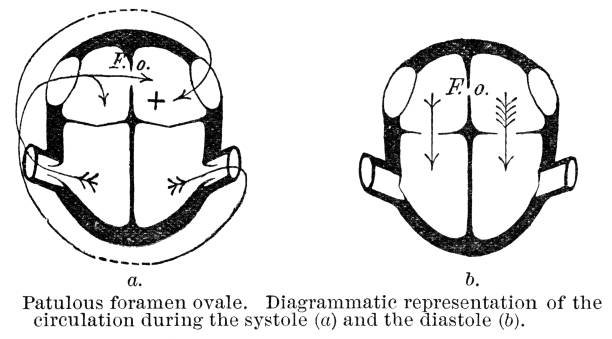
“Broken Hole” in the Heart! Does Your Baby Have One Too? Understanding the Symptoms and Treatment of Patent Foramen Ovale
The heart is one of the most important organs in the human body. Thanks to its regular beating day after day, we are able to carry out various daily activities. However, when the heart structure is abnormal, such as the foramen ovale that is not closed, will it affect the normal blood delivery and have adverse effects on health?
What exactly is a patent foramen ovale? It turns out that it might happen when a newborn is born? This article unveils the mystery of the foramen ovale for you.
What is the foramen ovale? Before the baby is born, there are foramen ovale
Before birth, the baby will absorb maternal nutrients through the umbilical cord vein. Most of the blood will enter the inferior vena cava through the umbilical vein, and then the blood from the lower limbs collected by the inferior vena cava will be directed into the baby’s right atrium.
The blood injected into the right atrium mixes with the blood brought by the superior vena cava, enters the left atrium through the foramen ovale, and then sends this blood to all parts of the body through the left ventricle.
Therefore, before the baby is born, the foramen ovale is present in every baby, and it is also necessary!
What is the condition of “unclosed” foramen ovale?
After the baby is born, due to the increased pressure in the left atrium, the foramen ovale, which has a membranous structure, usually closes. However, some newborns have incomplete closure of the foramen ovale due to their body structure, which is commonly known as incomplete foramen ovale. Closed (Patent Foramen Ovale, PFO), or open foramen ovale.
There is a hole in the baby’s heart OMG! Expert: Don’t panic yet! 95% can heal on their own before one year old
The foramen ovale is located between the left and right atria. Generally speaking, if the foramen ovale does not close in newborns within 2 weeks of birth, it is a normal physiological phenomenon. According to statistics from Taipei City United Hospital, 50% of babies with unclosed foramen ovale will gradually close after 3 months of birth; 95% of babies will close before they reach 1 year old.
If a child has an unclosed foramen ovale, it is generally recommended to wait until the baby reaches one year old before arranging a cardiac ultrasound examination;
What symptoms will an unclosed foramen ovale cause?
Many parents are worried when they hear that the foramen ovale is not closed: Will the baby develop adverse symptoms and affect its growth and development? In fact, unless the baby has other heart problems or abnormalities, most newborns with unclosed foramen ovale will not have clinical symptoms. The care is no different from that of ordinary babies and only requires regular follow-up examinations.
Should a non-closed foramen ovale be treated?
At present, non-closure of the foramen ovale can be treated through surgery or cardiac catheterization, but cardiac catheterization is usually the main method. If the patient does not have any discomfort or related complications, he only needs to return regularly to confirm the changes in the foramen ovale.
If the foramen ovale gradually enlarges or the patient has a history of ischemic stroke, the doctor will recommend appropriate treatment methods based on the patient’s condition.
Will an unclosed foramen ovale cause a stroke? Great question!
Some people may have heard that “unclosed foramen ovale can cause stroke.” However, Dr. Huang Siwei said that according to anatomical studies, one in four healthy adults has unclosed foramen ovale.
For example, he pointed out: “If an unclosed foramen ovale can cause a stroke, then if four adults go out for a dinner, there should be one stroke patient. But in fact, the number of people with strokes is not that large.” Therefore, “if the foramen ovale is not closed, there should be one stroke patient among them.” It is not true that closure can cause a stroke.
Where does the saying that “unclosed foramen ovale causes stroke” come from?
There are many causes of stroke. If the patient has done various examinations and searched for all the causes, but still cannot find the exact cause of the stroke. These patients will be classified as “cryptogenic stroke”. “
Studies have found that if these patients with “unexplained stroke” happen to have an unclosed foramen ovale, closing the foramen ovale at this time can prevent another stroke.
Therefore, a more correct statement should be: when an “unexplained stroke” occurs and the foramen ovale is not closed, closing the foramen ovale can prevent another stroke.

Unclosed foramen ovale can be improved through surgery
If the foramen ovale is not closed, the hole can be repaired through surgery. In the past, traditional surgery was used. However, surgery can easily cause wound infection and postoperative bleeding. Therefore, in recent years, “foramen ovale sealing surgery” has been adopted.
This operation is performed by inserting the catheter from the femoral vein of the mouse groin, passing through the inferior vena cava into the right atrium, passing the catheter from the foramen ovale to the left atrium, placing a foramen ovale closure device, and then withdrawing the catheter. . This surgery is short in duration, has small wounds, and has a quick recovery period. All you need to do after the operation is regular medication and follow-up for half a year.












